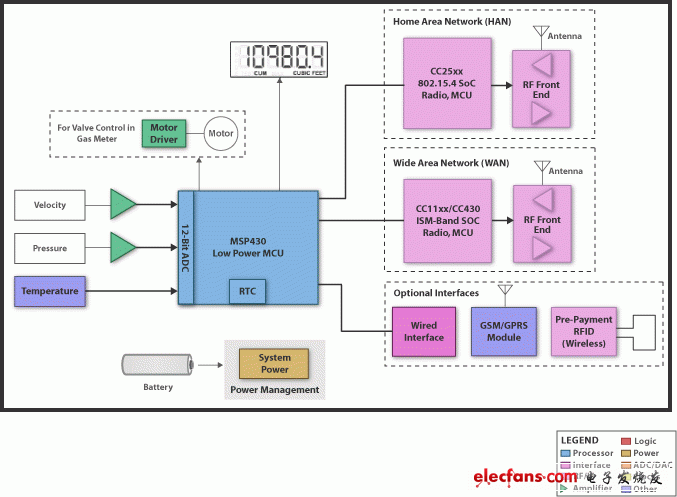Texas Instruments (TI) smart gas and water meter solutions
Design considerations
Gas and water AMR (Automated Meter Reading) is an electronic instrument (electronic meter) technology that includes measurement and one-way communication media. It collects and presents utility time synchronization interval meter data and provides customers with long-term power consumption Overview. It combines high-power endpoints, network receivers, data collection engines, and fixed network technologies to let providers know who uses how much gas and water when and when.
Gas and water AMI (Advanced Meter Reading Infrastructure) is sometimes called smart meter reading. As a dual-channel communication network, it adds other communication and control functions to AMR, including valve control and customer access to power consumption data.
TI provides a series of high-performance products that support many of the key functions required by today's AMR and AMI smart gas and water meters (from ultrasonic to mechanical). TI solutions provide the following features:
Two-way communication and time synchronization measurement
TI provides a low-power RF product series connected to TI MCUs (solutions below 1 GHz and 2.4 GHz). This type of communication enables early detection of leaks in these meters, and enables monitoring and customer awareness.
Logging and billing
Due to the need to implement flexible tariffs, it is essential to equip such systems where power consumption information is recorded. TI MCU solutions provide embedded flash technology to make this type of system a reality. In addition, TI provides solutions that use tamper-proof and prepaid RFID options, enabling the ultimate flexibility in today's smart gas meters.
Extend infrastructure life
To optimize service frequency, the battery life of such applications needs to last 10-15 years. TI's MSP430 ultra-low-power MCU series conforms to this idea well by combining high performance with low power consumption.

power supply
While maximizing battery life, the key to optimizing the low-power MSP430 lies in the correct selection of ultra-low quiescent current power management equipment. Although running the MCU directly from the battery may work (within the specified MCU operating range) and seems to save the cost of the power management component, the lack of voltage regulation will cause excessive standby power consumption and shortened battery life. This leads to higher maintenance costs, far exceeding all the cost savings caused by not using a voltage regulator. Stabilizing the MCU and peripheral communication IC to the lowest possible voltage will optimize the power saving function and extend battery life.
Depending on the type of battery used and the duty cycle (full load) of the meter, we have a variety of power management solution options. For simple applications that use a low duty cycle (long standby) with smooth discharge curve batteries (such as Li-SOCl2 original batteries), the use of ultra-low Iq LDO can provide longer battery life at a very low cost. For applications with a high duty cycle, using a low-Iq DCDC regulator in power-saving mode (for light loads) will provide higher efficiency on the basis of a moderate increase in cost.
For applications using batteries with linear discharge curves (such as multi-line alkaline or NiXX), using a low Iq buck / boost converter will maximize the life of the power supply by providing a stable discharge voltage as low as 1.8V. For single-cell batteries or small button batteries (in this case, the battery voltage can be lower than the regulation voltage), the use of a low-lq boost converter can provide an input voltage as low as 0.7V for the regulation voltage.
Although it is possible to optimize a fully operational MCU and peripheral communication IC at a certain voltage, these devices can still operate at a much lower voltage in standby mode (only RTC and memory are maintained). The use of DCDC converters and LDOs with dynamic voltage regulation (usually implemented through V-Select logic pins) can further extend battery life.
Analog sensing
The mechanical force of the gas meter is measured / detected by inductive sensors (flow rate), pressure sensors and RTD or silicon temperature sensors (temperature). Because the voltage is very low, precise low-noise amplifiers (for flow and temperature) and instrumentation amplifiers (for pressure) such as OPA2209 and INA10x are required at the front end, respectively. Usually, the voltage is digitized with the precision ADC integrated in the MSP430.
The mechanical structure of the ultrasonic instrument is much simpler than the diaphragm instrument, making the design more and more light and compact. Due to the special measurement method, this instrument is more sensitive and sensitive to leak detection than the diaphragm instrument, and the detection speed is faster, which can be used for a wider range of measurement. Ultrasonic instruments require a specific analog front end to detect the flow rate proportional to the time measurement and its accuracy between the two ultrasonic sensors. The devices currently being developed by TI will enable measurement accuracy as low as a few picoseconds, while also seamlessly connecting to the MSP430.
By supporting these features, TI enables you to make accurate bills, perform conventional gas system balancing and adjustment, achieve early detection of leaks, and provide real-time usage to better save energy.
CXLWGY series turbine flowmeter is optimized design with advanced technology of domestic and overseas flow meters. It is the new generation turbine flowmeter with the characteristics of simple structure , light and handy, high precision, good repeatability, sensitive response, easy installation and maintenance.
Turbine Flowmeter,Digital Flow Meter,Turbine Flow Meter,Turbine Flow Meter Oil Meter
Kaifeng Chuangxin Measurement & Control Instrument Co., Ltd. , https://www.kfcxflowmeter.com